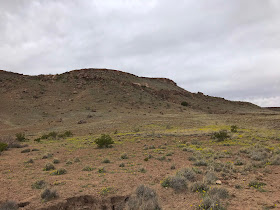


Deep gullies in the gray dirt, and bleached rock, tributaries to the main wash ( or draw as they're sometimes called) kept challenging our desire to keep a straight route through the valley, but usually we found cow paths that took us down and then back up the other side.
We made it to my destination: a ravine that tumbled steeply from the cliffs chock full of huge, orange and brown boulders. I'd been wanting to have a look here since a hike six years when I saw it from the main arroyo as I sat in the shade of a juniper. I knew I couldn't add it to my exploring that day in January or I'd be stumbling in the desert after dark, but have wanted to come back. There was a prize for returning: a single petroglyph, but what a one it was, a huge goggle-eyed figure (by far the biggest of the many I've seen). We searched and searched for even one other marking in the vicinity, but found nothing else.

Blue skies smiled on us briefly in the middle of our adventure, but then the gray overcast reassembled itself over our heads. Yellow wildflower patches, and birdsongs gave hope to a this wide vale of bunch grass, creosote and seemingly little else.


In and along the gullies, which can be completely hidden until you are at their edge and are deep enough to be a real hazard, mesquite trees, some large enough to really be called trees were still waiting to green up. These lowlands can seem stark until the summer rains arrive and give this place life. This year, because of all the winter moisture, it will happen quite a bit earlier than scheduled.
Near the end of our walking I pondered about barren patches where nothing seems to want to grow. I heard the ducks on the water of the tank. I saw the cows in the distance, like toy figures placed in pale tousles of grass that grow in the low spots of this landscape. I wanted to start all over again.








No comments:
Post a Comment